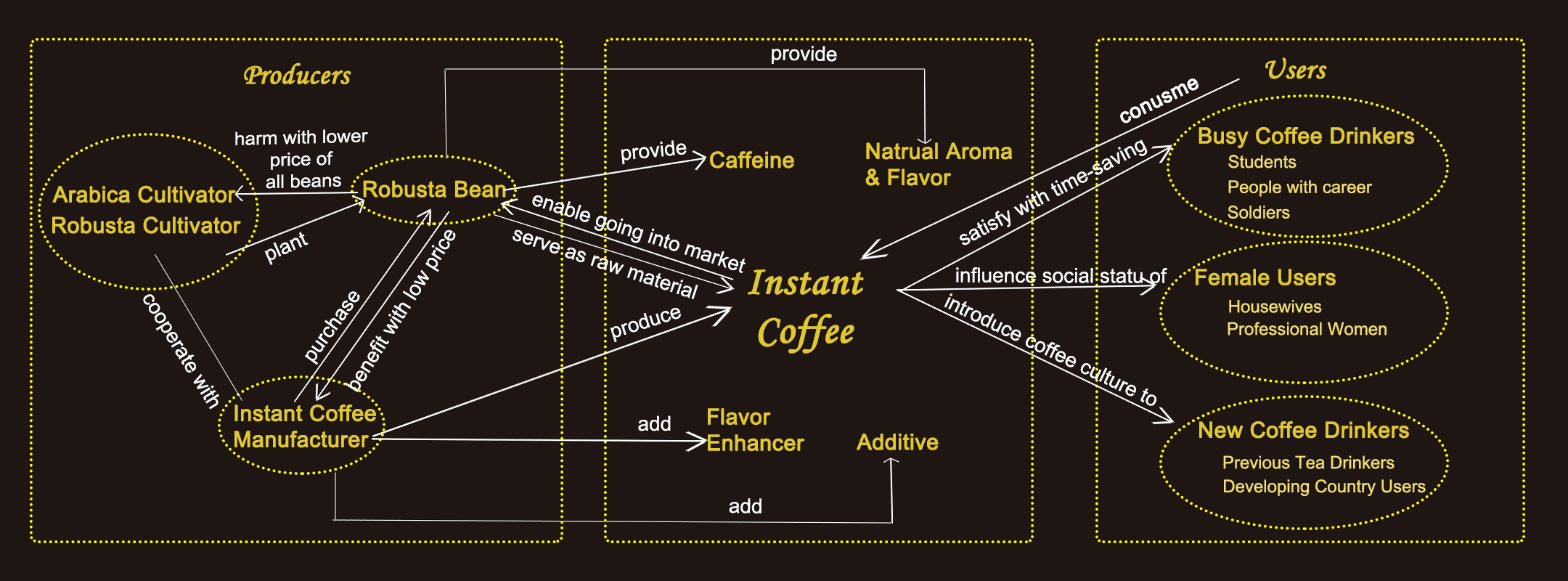
Producers:
For the producer and raw material suppliers, the invention of instant coffee is of great significance. Before instant coffee was mass produced, the Arabica coffee bean variety was the main source of coffee beans. Even now, Arabica accounts for about 60% of coffee bean production. However, the mass production of instant coffee allowed Robusta beans to enter the world market. Compared to Arabica beans, Robusta’s taste is stronger and bitter, one could equate the test to “burnt tires” or “rubber”. One benefit of the Robusta coffee bean variety is its high caffeine content, between 1.5% and 3.6%, which is almost twice of Arabica. This is useful as some of the caffeine is lost during the instant coffee production process. Because it is easier-to-care for and has a greater crop yield than Arabica beans, Robusta has a cheaper price. But due to its flavor, it was rarely utilized. Instant coffee created a greater market for Robusta beans. Its cheap cost is favored by instant coffee makers. The change has two consequences. First, more countries have become coffee exporters. Arabica coffee beans do best with 40–59 inches of rain and are usually cultivated between 1,300 and 1,500-meter altitude. This makes Latin America and East Africa the best origin place for cultivation. In contrast, Robusta fits an environment with 78-118 inches rainfall and 0-900-meter altitude. The main origins for Robusta are West Africa, Brazil and tropical area in Asia. Vietnam, which was introduced to Robusta during the French colonial period, now is the largest exporter of Robusta. Second, Robusta makes the whole production value larger than before, which in turn, makes the giants in the roasting industry, like Nestle, have huge leverage over the market. Both traditional Arabica producers like Mexico and Robusta exporters like Vietnam have suffered during coffee crisis due to the low price of raw beans.
Gender Relationship:
Instant coffee influenced the status of females. On one hand, instant coffee has liberated women from tedious coffee brewing in the household and gave them time to work and study when it first appeared. However, from another side, the appearance of instant coffee devalues the job of housewives and make their contribution to a family easier to be ignored. Back in 1950s, Nescafe initially failed in promoting instant coffee, because they chose housewives as target audience and advertised its convenience. But housewives thought if they spent less time on brewing coffee, their family members would think they are lazy housewives. Instant coffee offered an easily-accessible and cheap substitute to the housewives’ work.
Coffee Culture:
Instant coffee undoubtedly has made a great contribution to the popularity of coffee culture. It stimulates the coffee consumption significantly in two kinds of countries: developing countries and traditional tea-drinking societies. Developing countries in Asia and the Middle East contributed the greatest portion to the $28 billion instant coffee market. China’s estimated revenue in the instant coffee sector is $2 billion. Relatively low requirement on coffee quality, lower consumption levels, and stressful work makes consumers in developing countries prefer instant coffee. The convenience especially pleases tea drinkers. In 2013, tea bag sales dropped 17.3 percent while sales of Nescafé instant coffee went up in supermarkets by more than 6.3 percent in Great Britain, the country with a famous tea-drinking tradition. A similar situation happened in Japan, Iran and Turkey. Although coffee culture is not unique in the US, and instant coffee was not originally invented by Americans, the popularity of instant coffee is seen as an effect of America’s soft power. First, the US’s role in promoting instant coffee is undeniable. Instant coffee stimulated the soldiers in battle fields from WWII to Vietnam. In South Korea, a country once was called “kingdom of instant coffee”, instant coffee was introduced during the Korean War through the American military ration food on black market. Second, the simplicity of instant coffee somehow accords with American lifestyle, and the worldwide spread of it could be a soft publicity of American spirit. The coffee culture in Australia serves as a good example. Under the deep influence of Great Britain, Australians used to predominantly drink tea. But after Australians embraced instant coffee, the convenience drove Australians to move to coffee from tea, and become interested in America’s efficient and smart lifestyle, instead of the elegant and hierarchical English manner. Today, more than 75% of retail brewed coffee consumed in Australia and New Zealand is instant. For more developing countries, when they accepted and favored western lifestyle including eating and drinking habits, they actually were accepting US culture. After all, US is often seen as a prime example of western countries.
Bibliography
- How Nescafé convinced women, AdWomen , 2009, Mar 25 2018
- Instant coffee in China, Statista. N.D. Mar 25 2018 https://www.statista.com/outlook/30010200/117/instant-coffee/china#
- Lacsamana, Pauline, Instant Coffee Popularity Increases in Global Market, The daily meal, Nov 30 2016, Mar 25 2018. https://www.thedailymeal.com/news/drink/instant-coffee-popularity-increases-global-market/113016
- Phillip Vannini, Jonathan Taggart. (2014) Growing, Cooking, Eating, Shitting Off-grid Organic Food. Food, Culture & Society 17:2, pages 319-336.
- Renard, Marie-Christine and Mariana, tr Ortega Breña. “The Mexican Coffee Crisis /.” [“Part of a special issue: Globalization, Neoliberalism, and the Latin American Coffee Societies”]. Latin American Perspectives, vol. 37, no. 2, Mar. 2010, pp. 21-33. EBSCOhost, doi:10.1177/0094582X09356956.
- Sangmee, Bak. “From strange bitter concoction to romantic necessity: the social history of coffee drinking in South Korea.” Korea Journal 45.2 (2005): 37-59.
- Sullivan, Rebecca, Australians love instant coffee, Euromonitor report says, news.com.au, Jul 16,2014, Mar 25 2018.
- Susie Khamis (2015) “It Only Takes a Jiffy to Make”. Nestlé, Australia and the Convenience of Instant Coffee
- Topik, Steven, et al. “Introduction: Globalization, Neoliberalism, and the Latin American Coffee Societies.” Latin American Perspectives, vol. 37, no. 2, 2010, pp. 5–20. JSTOR, JSTOR, www.jstor.org/stable/20684712.